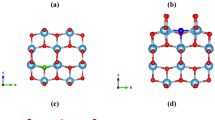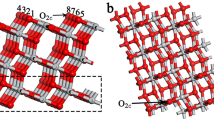Abstract
Self-energy correction density functional theory local density approximation–1/2 (LDA-1/2) method was successfully applied to predict the electronic structure and optical properties of the N-doped, Ti-vacant Ti3−δO4N oxynitride [G. Hyett et al., J. Am. Chem. Soc. 129, 15541–15548 (2007)], which was shown experimentally to be more photocatalytic than titania. The procedure takes into consideration of the two possible types of Ti vacancies (with different numbers of nitrogen and oxygen neighbors) and their formation energies, according to the experimental data on fractional occupancies, with potential effects on the electronic structure and photocatalyst mechanisms analyzed. Different defective model structures were calculated for optimal final configuration, whose optical calculations revealed massive damping in infrared spectrum, while transparency in green region. The band gap determined by our methodology is 2.5 eV, in close agreement to the experimental value of 2.6(1) eV. Results presented in this work represent the first report of an electronic structure modeling of Ti3−δO4N, which is a starting point to help provide an understanding of its photocatalytic activity.




Similar content being viewed by others
References
A. Walsh, K-S. Ahn, S. Shet, M.N. Huda, T.G. Deutsch, H. Wang, J.A. Turner, S-H. Wei, Y. Yana, and M.M. Al-Jassima: Ternary cobalt spinel oxides for solar driven hydrogen production: Theory and experiment. Energy Environ. Sci. 2, 774–782 (2009).
A. Fujishima and K. Honda: Electrochemical photolysis of water at a semiconductor electrode. Nature 37, 238 (1972).
A.L. Linsebigler, G. Lu, and J.T. Yates: Photocatalysis on TiO2 surfaces: Principles, mechanisms, and selected results. Chem. Rev. 95, 735–758 (1995).
H. Tang, F. Levy, H. Berger, and P.E. Schmid: Urbach tail of anatase TiO2. Phys. Rev. B 52, 7771–7774 (1995).
H.B.H. Tang, P.E. Schmid, F. Lévy, and G. Burri: Photoluminescence in TiO2 anatase single crystals. Solid State Commun. 87, 847–850 (1993).
M. Batzill, E.H. Morales, and U. Diebold: Influence of nitrogen doping on the defect formation and surface properties of TiO2 rutile and anatase. Phys. Rev. Lett. 96, 026103 (2006).
R. Asahi, T. Morikawa, T. Ohwaki, K. Aoki, and Y. Taga: Visible-light photocatalysis in nitrogen-doped titanium oxides. Science 293, 269 (2001).
G. Hyett, M.A. Green, and I.P. Parkin: The use of combinatorial chemical vapor deposition in the synthesis of Ti3−δO4N with 0.06 < δ < 0.25: A titanium oxy-nitride phase isostructural to anosovite. J. Am. Chem. Soc. 129, 15541–15548 (2007).
P. Hohenberg and W. Kohn: Inhomogeneous electron gas. Phys. Rev. 136, B864–B871 (1964).
W. Kohn and L.J. Sham: Self-consistent equations including exchange and correlation effects. Phys. Rev. 140, A1133–A1138 (1965).
J. Wang, D.N. Tafen, J.P. Lewis, Z. Hong, A. Manivannan, M. Zhi, M. Li, and N. Wu: Origin of photocatalytic activity of nitrogen-doped TiO2 nanobelts. J. Am. Chem. Soc. 131, 12290–12297 (2009).
G. Onida, L. Reining, and A. Rubio: Electronic excitations: Density-functional versus many-body Green’s-function approaches. Rev. Mod. Phys. 74, 601 (2002).
C. Fiolhais, F. Nogueira, and M. Marques eds.: A Primer in Density Functional Theory, 1st ed. (Springer, New York, 2002).
W.M.C. Foulkes, L. Mitas, R.J. Needs, and G. Rajagopal: Quantum Monte Carlo simulations of solids. Rev. Mod. Phys. 73, 33–83 (2001).
M. Ribeiro, Jr.: Application of the GGA-1/2 excited-state correction method to p-electron defective states: The special case of nitrogen-doped TiO2. Can. J. Phys. 93(3), 261–266 (2015).
M. Ribeiro, Jr. and S. Shevlin: Self-energy corrected ab initio simulation of the photo-catalytic material nitrogen doped rutile TiO2. Sci. Adv. Mater. 7, 623–630 (2015).
J.F. Janak: Proof that ∂E/∂ni=ε in density-functional theory. Phys. Rev. B 18, 7165 (1978).
J.C. Slater and K.H. Johnson: Self-consistent-field Xα cluster method for polyatomic molecules and solids. Phys. Rev. B 5, 844 (1972).
J. Mauro Ribeiro, L.R.C. Fonseca, and L.G. Ferreira: Accurate prediction of the Si/SiO2 interface band offset using the self-consistent ab initio DFT/LDA-1/2 method. Phys. Rev. B 79, 241312(R) (2009).
M. Ribeiro, Jr., L. Fonseca, and L.G. Ferreira: First-principles calculation of the AlAs/GaAs interface band structure using a self-energy–corrected local density approximation. Europhys. Lett. 94, 27001 (2011).
M. Ribeiro, Jr., L.G. Ferreira, L.R.C. Fonseca, and R. Ramprasad: CdSe/CdTe interface band gaps and band offsets calculated using spin–orbit and self-energy corrections. Mater. Sci. Eng., B 177, 1460–1464 (2012).
M. Ribeiro, Jr., L.R.C. Fonseca, T. Sadowski, and R. Ramprasad: Ab initio calculation of the CdSe/CdTe heterojunction band offset using the local-density approximation-1/2 technique with spin-orbit corrections. J. Appl. Phys. 111, 073708 (2012).
J.M. Soler, E. Artacho, J.D. Gale, A. García, J. Junquera, P. Ordejón, and D. Sánchez-Portal: The SIESTA method for ab initio order-N materials simulation. J. Phys.: Condens. Matter 14, 2745–2779 (2002).
D.M. Ceperley and B.J. Alder: Ground state of the electron gas by a stochastic method. Phys. Rev. Lett. 45, 566–569 (1980).
H.J. Monkhorst and J.D. Pack: Special points for Brillouin-zone integrations. Phys. Rev. B 13, 5188–5192 (1976).
S. Åsbrink and A. Magnéli: Crystal structure studies on trititanium pentoxide, Ti3O5. Acta Cryst. 12, 575 (1959).
G. Hyett, M.A. Green, and I.P. Parkin: Ultra-violet light activated photocatalysis in thin films of the titanium oxynitride, Ti3−δO4N. J. Photochem. Photobiol., A 203, 199–203 (2009).
M. Landmann, E. Rauls, and W.G. Schmidt: The electronic sructure and optical response of rutile, anatase and brookite TiO2. J. Phys.: Condens. Matter 24, 195503 (2012).
Author information
Authors and Affiliations
Corresponding author
Rights and permissions
About this article
Cite this article
Ribeiro, M. Quasiparticle theoretical characterization of electronic and optical properties of the photocatalytic material Ti3−δO4N. Journal of Materials Research 30, 2934–2939 (2015). https://doi.org/10.1557/jmr.2015.185
Received:
Accepted:
Published:
Issue Date:
DOI: https://doi.org/10.1557/jmr.2015.185




